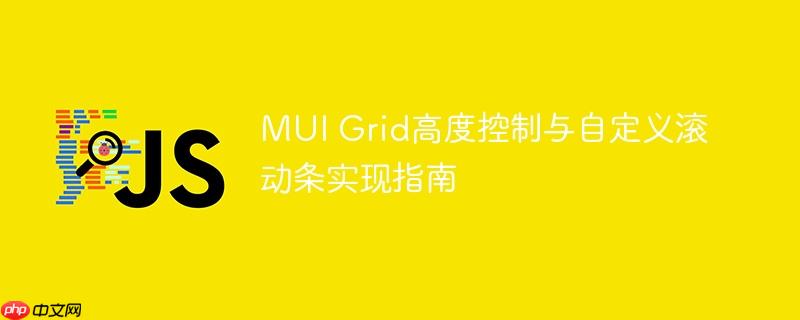
在使用material-ui(mui)的grid组件时,开发者常遇到无法直接通过css属性如height: 100vh或height: 100%来限制其高度的问题。这是因为mui grid本质上是一个flex容器,其高度行为高度依赖于其父容器。如果父容器没有明确的高度定义,或者没有正确配置flexbox属性,grid组件将无法正确计算并限制自身高度,导致内容溢出时出现浏览器整体滚动条,而非组件内部的自定义滚动条。
为了解决这一问题,关键在于为MUI Grid提供一个具有明确高度和正确Flexbox布局的父容器。
核心思路是创建一个包装MUI Grid的div元素,并对其应用特定的Flexbox样式,使其能够填充可用空间并在内容溢出时显示内部滚动条。
在React组件中,可以通过内联样式或CSS模块来实现:
import React from 'react';
import { Grid } from '@mui/material'; // 假设你在这里使用MUI Grid
const ExampleLayout = () => {
return (
// 最外层容器,通常会设置其高度,例如:height: '100vh' 或 '100%'
<div style={{ display: 'flex', width: '100%', height: '100vh', flexDirection: 'column' }}>
{/* 头部或顶部区域(可选) */}
<div style={{ height: '64px', background: '#f0f0f0', padding: '10px' }}>
Header Content
</div>
{/*
MUI Grid的包装容器
- display: 'flex':使其成为一个Flex容器
- flex: '1 1 0%':核心属性,让此容器在主轴方向(此处为垂直方向,因为父级flexDirection: 'column')上填充剩余空间
- flex-grow: 1:允许容器增长以占据可用空间
- flex-shrink: 1:允许容器缩小以适应空间不足
- flex-basis: 0%:定义了在分配剩余空间之前元素的初始主轴尺寸。设置为0%表示元素在分配空间前不占据任何空间,所有空间都将根据flex-grow分配。
- overflow: 'auto':当内容超出此容器的高度时,自动显示垂直滚动条
*/}
<div style={{ display: 'flex', flex: '1 1 0%', overflow: 'auto' }}>
{/* 在这里放置你的MUI Grid组件 */}
<Grid container style={{ width: '100%' }}>
{/* 示例内容,模拟大量内容以触发滚动条 */}
{Array.from({ length: 50 }).map((_, index) => (
<Grid item xs={12} key={index} style={{ padding: '10px', borderBottom: '1px solid #eee' }}>
Grid Item {index + 1} - This is some content that will eventually cause scrolling.
</Grid>
))}
</Grid>
</div>
{/* 底部或页脚区域(可选) */}
<div style={{ height: '48px', background: '#e0e0e0', padding: '10px' }}>
Footer Content
</div>
</div>
);
};
export default ExampleLayout;关键解释:
如果倾向于使用外部CSS文件或CSS-in-JS库的类名,可以这样实现:
/* App.css 或你的样式文件 */
.page-wrapper {
display: flex;
width: 100%;
height: 100vh; /* 确保页面容器有明确高度 */
flex-direction: column; /* 如果是垂直布局 */
}
.header-div {
height: 64px;
background: #f0f0f0;
padding: 10px;
}
.grid-wrapping-div {
display: flex;
flex: 1 1 0%; /* 核心属性,使其填充剩余空间 */
overflow: auto; /* 溢出时显示滚动条 */
}
.footer-div {
height: 48px;
background: #e0e0e0;
padding: 10px;
}然后在你的React组件中应用这些类:
import React from 'react';
import { Grid } from '@mui/material';
import './App.css'; // 导入你的CSS文件
const ExampleLayoutWithCss = () => {
return (
<div className="page-wrapper">
<div className="header-div">
Header Content
</div>
<div className="grid-wrapping-div">
<Grid container style={{ width: '100%' }}>
{/* 示例内容 */}
{Array.from({ length: 50 }).map((_, index) => (
<Grid item xs={12} key={index} style={{ padding: '10px', borderBottom: '1px solid #eee' }}>
Grid Item {index + 1} - This is some content that will eventually cause scrolling.
</Grid>
))}
</Grid>
</div>
<div className="footer-div">
Footer Content
</div>
</div>
);
};
export default ExampleLayoutWithCss;通过为MUI Grid组件提供一个配置了display: flex、flex: 1 1 0%和overflow: auto的父容器,可以有效地控制其高度,并为溢出内容提供独立的滚动条,从而实现更精确的页面布局管理,避免不必要的浏览器滚动。理解Flexbox的工作原理是解决此类布局问题的关键。
以上就是MUI Grid高度控制与自定义滚动条实现指南的详细内容,更多请关注php中文网其它相关文章!

每个人都需要一台速度更快、更稳定的 PC。随着时间的推移,垃圾文件、旧注册表数据和不必要的后台进程会占用资源并降低性能。幸运的是,许多工具可以让 Windows 保持平稳运行。

Copyright 2014-2025 https://www.php.cn/ All Rights Reserved | php.cn | 湘ICP备2023035733号